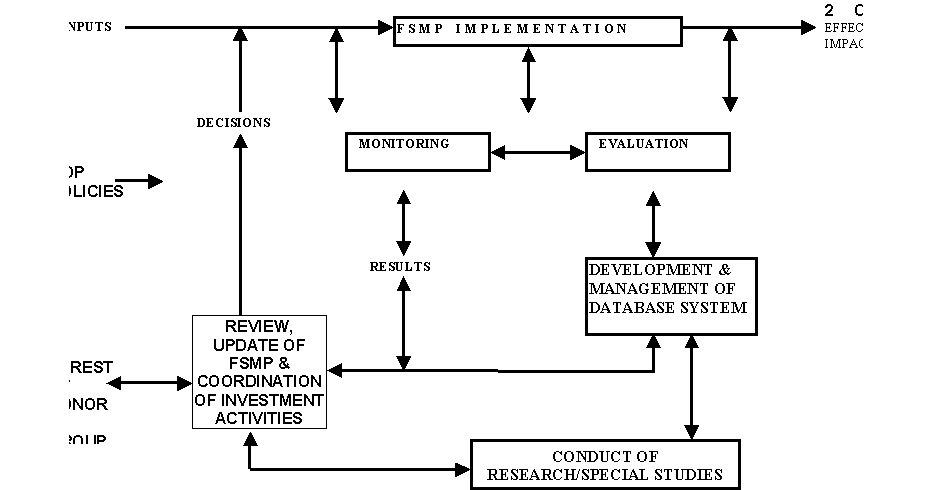Tariq Nazir
Section Officer Forests
Ministry of Environment, Local Government & Rural Development
Islamabad
BACKGROUND
The forestry sector plays a highly important role in Pakistan's economy. It employs half a million people and provides 3.5 million cubic meters of wood to meet industrial requirements and provides almost one third (15 million tonnes of oil equivalent) of Pakistan's energy needs. Forests and rangelands support about 30 million livestock. Livestock industry's contribution exceeds US$400 million to Pakistan's annual export earnings.
Contribution of forestry to Gross Domestic Product (GDP) reflects the value of material goods only. In 1997-98, contribution was estimated at Rs. 739 million or 0.12 percent of the national GDP. While economic value of forests in terms of cash earnings is based on wood resources, there is a growing concern that this role cannot be seen exclusively in terms of wood products. The role which the forestry sector plays in soil conservation, regulating flow of water for irrigation and power generation, reduction of sedimentation in water conveyances and reservoirs, employment, outdoor recreation and maintenance of ecological balance far exceeds the direct economic benefits. According to the concept of forests for people, value links between forests and communities, though not measured quantitatively cannot be under-estimated.
Forests provide forage to one third of Pakistan's 90 million head of livestock. Leather, wool and other livestock products contribute US $ 400 million or 9 percent of total export earnings. Rangelands comprising 28.50 million ha including 6.28 million ha under Forest Departments' control is 32 percent of total area of Pakistan. Rangelands are degraded to one-third of their productive potential. Forests and rangelands support a variety of flora and fauna.
There is a long history of over- exploitation of forests and rangelands in Pakistan. Consequently, fragile ecosystems have been severely degraded. Out of Pakistan's total landmass of 87.98 million hectares, state owned forest area consists of 4.25 million hectares (4.8 percent).
Pakistan is deficient in timber production. Growing needs for wood and wood products are satisfied through imports. Pakistan imported 966,940 tonnes of wood and wood products in 1997-98 at the cost of Rs. 8,063 Million. During 1993-94 Rs. 4,905 million were spent on import of wood and wood products as compared to Rs. 2,880 million in 1994-95, Rs. 7,073 million in 1995-96 and Rs. 7,382 million in 1996-97, showing an increase in imports. A similar trend in export of wood products is observed.
Self-sufficiency in wood production from the meagre 4.8 percent of public forests cannot be attained due to priority assigned to agriculture for resource allocation in physical and financial terms and climatic limitations. To meet the growing wood requirement of Pakistan, potential lies with cultivated area spread over 20.85 million ha, uncultivable area of 25.63 million ha and cultivable but undeveloped plain of 9.30 million ha. Promotion of social forestry/agroforestry will directly expand the forestry resource base. Expanded forestry resource base will contribute to meet 53 percent of household energy needs and wood-based industry, stabilize environment, reduce pollution, generate income-earning opportunities and alleviate rural poverty.
Forest planning processes
After independence, pakistan adopted land development approach for socio-economic development in the country. A planning commission was constituted to carry out the job for the entire country. Over the years nine five-year plans and a few annual plans to take the process of planning were developed on the pre-determined directions.
The national executive council (ecnec) approved the objectives of each five-year plan. The objectives represent the shared vision of the people in regard to their socio-economic development. It comprises development goals, strategy, policies and thematic issues and sectoral programs to achieve the objectives set for the economic development of the nation. The data for preparation of forestry plan is collected from the following sources:
Provincial working plans and management plans;
Annual plantation reports; and
Resource surveys by state.
Annual targets for massive tree plantation campaign are fixed at federal level twice a year in monsoon and spring. The provincial chief conservator of forests presents review reports of the targets achieved, bottlenecks, etc.
Planning at provincial level
The provincial development working party (pdwp) under the chairmanship of the governor approves the provincial plan at state level. The sectoral targets are received from the central government and feedback is taken from local level. The cdwp finalizes the targets and programs to achieve the targets for various sectors. The sectoral allocations are made on the following criteria:
Fully funded projects through provincial resources;
Partially funded projects by province and partially by the central government; and
Fully funded by the central government.
PLANNING AT DISTRICT LEVEL
District councils are responsible for formulation of district plans. The provincial government determines the target for each sector. Then action programs to meet these targets are prepared. Their working plans and resource survey data provide the basis for formulation of specific schemes and projects. After appraisal and evaluation, district plans are included in the provincial plans, which are further appraised for inclusion in the national plan.
It is pertinent to note here that there is no direct link between district plans and forest management plans prepared by the forest division. The forest management plans are prepared for a period of 10-20 years in accordance with the objective and priorities outline in the national forest policy and framework of five year plan. The forest working plans are approved by the provincial forest departments. Funds are allocated by the planning section of the forest department.
The weaknesses of present planning processes
Top to down approach
Lack of integration and coordination
Highly centralize and directive base
Lack of participatory spirit and methodology
Lack of watershed and ecosystem functioning management
Lack of modern tools and technology
Lack of grass root orientation.
The office of the inspector general of forests is implementing a component of forestry sector project with the financial assistance of asian development bank. Its objectives are:
Design a system for coordinating investment activities and identification and preparation of forestry projects for donor and domestic funding within the framework of fsmp;
Monitor and evaluate the effectiveness of various programs in the forestry sector and institutionalize the system countrywide;
Review and refine the fsmp priorities and strategies by undertaking special studies of national importance in research, education/extension, policy, land tenurial systems, forest management, marketing of forest products and codification of legal instruments; and
Develop a forestry database and update the fsmp.
The office of inspector general is working to develop a monitoring and evaluation system. The purpose of monitoring is to achieve efficient and effective implementation by providing feedback to project management at all levels. This enables management to improve operational plans and to take timely corrective action in case of shortfalls and constraints. Monitoring is thus a part of the management information system and is an internal activity. As an integral component of the management function and hence an essential part of good management practice, monitoring needs to be conducted by those responsible for project/ programme implementation at every level of the management hierarchy.
Evaluation is a process of assessing systematically and objectively the relevance, efficiency, effectiveness and import of activities in the light of the objectives. It is a process of determining what has been accomplished and comparing them with what should have been accomplished and providing ways of improving implementation of activities still in progress and helping management in planning and programming future projects.
Monitoring and evaluation, taken together, form a unified system and a vital function of management. Both are tools for analyzing sound decisions. Regular periodic reports on the human resources, physical and financial inputs and outputs supplemented by information from existing databases and special studies provide the basis for monitoring analysis. On the other hand, these monitoring analyses supplemented by some in-depth studies provide a basis for on-going evaluation. Together, these two processes supplemented by biophysical and socio-economic data provide the basis for major, terminal or ex-post evaluation.
The proposed framework will help in
Formulating, developing and reviewing the national policy framework for sustainable development;
Undertaking action research to support the economic importance of forestry in the country;
Identifying policy gaps in the forestry sector master plan;
Coordinating the national response and participation in the international environment conventions; and
Promoting and communicating sustainable development awareness.
framework of proposed monitoring work


